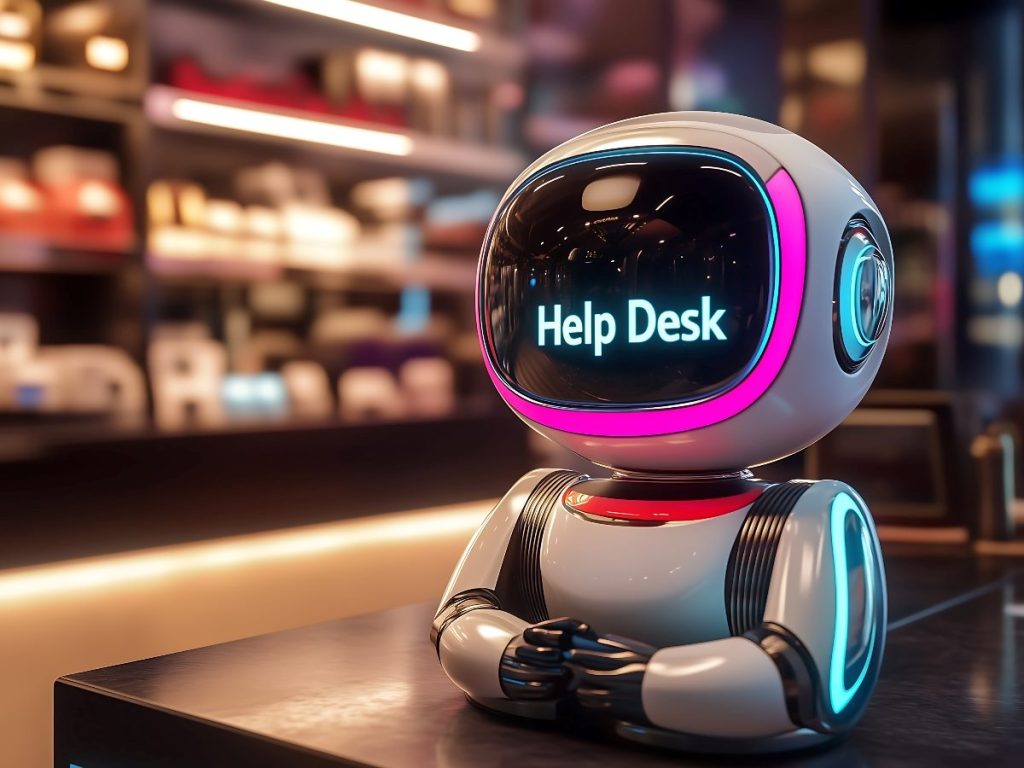The Gist
Start with the basics. Use AI for chatbots and repetitive CX tasks to reduce wait times and lower operational costs.
Build loyalty with advanced tech. Use real-time customer data to allow AI-driven personalization and uncover hidden insights.
Improve uptime and digital resiliency. Keep your devices online with proactive IT, thanks to predictive analytics and self-healing systems.
A decade ago, Rachel Drori started creating and sharing homemade smoothies with her friends. Today, her billion-dollar meal delivery company, Daily Harvest, has an estimated 100,000+ customers.
But it hasn’t lost the personal touch, thanks in part to AI. At Daily Harvest, AI gives customers self-service options, powers a chatbot that provides answers in seconds, and identifies high-risk customers to connect with a customer service agent. The company has saved money and seen a rise in customer success scores.
Table of Contents
How AI in Customer Experience Improves Service
Just as online shopping, self-checkout and other tech-driven innovations have transformed the customer service experience, new digital tools allow even small and mid-sized companies to improve their CX significantly.
These days, customer experience is “a seamless digital and physical interaction,” said Vivek Gurumurthy, the senior VP and CIO of Verizon Consumer and Business Group. The problem, he added, is that IT has historically been structured to facilitate customer transactions rather than improve customer experiences. But when you view IT as a proactive CX resource instead, you can use it to create resilient tech platforms, personalized customer experiences and adaptable digital ecosystems.
Here are a few ways leading companies transform customer service by embedding tech throughout the customer journey.
Handling Repetitive Tasks Quickly
When will my package arrive? How do I reset my password? These high-volume, straightforward queries are perfect for AI chatbots, which can handle multiple languages and dialects. Your customers will be happier with shorter wait times. Your employees will appreciate more time to handle complex support needs. And your CFO will thank you for the cost savings. In one case, university students who used a chatbot for support scored nearly five marks higher on average.
Building Loyalty Through Context and Consistency
An agent having a bad day can cost you a customer for life. In fact, 80% of customers said they have switched brands because of poor customer experience, according to research from Qualtrics and ServiceNow.
Providing agents with more customer context helps mitigate these risks. At Verizon, for example, AI gave customer service representatives instant access to information about the customer, the interaction and the context. Now, more than 40,000 Verizon reps use AI-driven tools to support customers and make sure everyone is on the same page. After all, your customers shouldn’t have to repeat themselves or reexplain their preferences every time they interact with your company.
Personalizing the Experience and Anticipating Customer Needs
AI-driven solutions can analyze real-time customer data from multiple sources, review their accounts and present highly individualized solutions perfectly matched to the consumer’s tastes and needs. And if there’s a shipping delay or another problem with an order, AI can proactively identify the issue and present various solutions to the customer based on their preferences.
Uncovering Customer Insights
What’s driving a spike in negative reviews or a flurry of comments on your social media channels? AI can sort through vast volumes of data, look for patterns and discover in seconds what might take an analyst a week or more.
Automating AI in Customer Experience to Power Self-Healing Devices
With automated scripts, predictive analytics and self-healing systems, you can improve uptime and reliability for your kiosks, POS systems, handheld devices and laptops. Organizations can resolve dozens of common issues across thousands of devices this way, often before the users notice a potential problem.
Improving Operations Related to CX Scores
Let’s say a healthcare provider notices lower throughput and billing for specific clinicians. When they look more closely, they discover that the issues were tied to poor endpoint performance in the clinicians’ electronic devices. AI-powered monitoring can identify and often resolve these types of issues, which improves the digital experience for employees and customers. It also can help increase overall efficiency and revenue.
Learning OpportunitiesView all
How AI Enhances Customer Experience
This table summarizes the major ways AI improves CX, based on examples and expert insights from industry leaders like Verizon.
AI-Driven CapabilityWhat It DoesWhy It MattersRepetitive Task AutomationHandles FAQs like delivery status and password resets using multilingual AI chatbots.Reduces wait times, improves customer satisfaction, and frees up human agents for complex tasks.Contextual SupportGives agents real-time customer context and interaction history via AI tools.Prevents repetition for customers and improves agent consistency; boosts loyalty and retention.Hyper-PersonalizationAnalyzes real-time customer data to deliver tailored product recommendations and proactive support.Improves satisfaction, drives conversions and strengthens brand trust.Customer Insight DiscoveryUses pattern recognition to surface causes behind negative reviews or social media spikes.Accelerates decision-making and reduces manual analysis time.Self-Healing SystemsApplies predictive analytics to fix device issues before users are impacted.Enhances reliability and reduces downtime for kiosks, POS systems and employee devices.Operational Efficiency MonitoringDetects performance problems in clinician devices that affect throughput and billing.Improves both digital and physical experiences while increasing revenue potential.
Preparing for Advances in AI
We are seeing several trends as AI in customer experience continues to drive innovation. These include the use of more chatbots, higher-quality responses, a greater emphasis on predictive analytics and the rise of agentic AI.
But while it’s exciting to watch new use cases emerge for technology, don’t forget about your people. The vast majority of your workforce likely didn’t grow up with AI. They need training and upskilling to learn how to use it responsibly to its full potential without exposing your company to more risk.
Remember that even the most powerful AI won’t replace human insight, at least not yet. Rather, AI in customer experience is most effective when used alongside traditional customer service and when it allows your human agents to make better decisions and deliver the first-class service your customers deserve.
Learn how you can join our contributor community.

